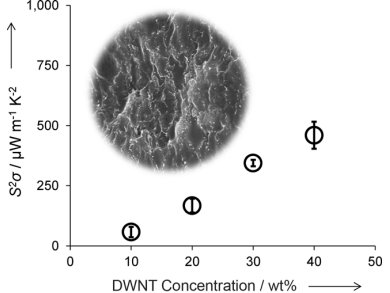Thermoelectric materials have the ability to convert a temperature gradient into useful electricity. Temperature gradients provide an environmentally friendly and abundant energy resource. These gradients are commonly produced by a number of processes, for example combustion engines, home appliances, and the human body. This waste heat can be harnessed by using thermoelectric devices, which until now have generally contained heavy and expensive elements, and have proposed a number of toxicity issues.
Jaime Grunlan and his co-workers, Texas A&M University, College Station, USA, have been working towards creating fully organic and electrically conducting composites as an alternative to traditional inorganic thermoelectric devices. They have successfully produced carbon nanotube-based polymer nanocomposites that are dual-stabilized to ensure the efficient movement of charge carriers.
The optimized materials exhibit high electrical conductivities and thermo-power values that are superior to other polymer-based composites. The dual-stabilized system can be used to enhance the thermoelectric properties of other organic materials for harvesting waste heat, and has the potential to be used instead of traditional inorganic semiconductor materials in thermoelectric devices. This new, flexible material also highlights the possibility of harvesting waste heat from unexpected places, such as the fibers in clothing, and the ability to convert that heat into a voltage.
- Fully Organic Nanocomposites with High Thermoelectric Power Factors by using a Dual-Stabilizer Preparation,
Gregory P. Moriarty, Kenneth Briggs, Bart Stevens, Choongho Yu, Jaime C. Grunlan,
Energy Technol. 2013.
DOI: 10.1002/ente.201300018


